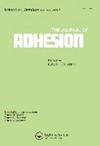Effect of reinforcement phases and post-cure temperature on adhesively bonded hybrid patch repair in indented glass/epoxy composite laminates
IF 2.3
4区 材料科学
Q2 ENGINEERING, CHEMICAL
引用次数: 1
Abstract
ABSTRACT This paper focuses on the experimental investigation on the effect of different fiber reinforcement phases and post-cure temperature to improve the strength recovery of adhesively bonded patch repair in glass/epoxy composite laminates. The repair was performed on the site of damaged region in the laminates by using various configurations of patches such as chopped glass (CG), chopped glass/carbon (CGC), chopped glass/kevlar (CGK), ply-by-ply glass (PG), ply-by-ply glass/carbon (PGC), ply-by-ply glass/kevlar (PGK), stitched glass (SG), stitched glass/carbon (SGC), and stitched glass/kevlar (SGK). The result reveals that the SGK hybrid patch repaired laminates offered a strength recovery by 101.5% as compared with damaged laminates. Further, the SGK hybrid patch was subjected to post-cure temperatures of 50°C, 70°C, 90°C, and 110°C which were considered based on the glass transition temperature (Tg) of glass/epoxy laminates. The result shows that the SGK hybrid patch with a post-cured temperature of 50°C has equal strength with virgin laminates and the strength recovery was improved by 112.9% as compared with damaged laminates. This study concluded that the adhesively bonded hybrid patch repair with a post-cure temperature of 50°C can be used for various fiber-reinforced polymer (FRP) industries to repair laminated composites.增强相和固化后温度对压痕玻璃/环氧复合材料层合板粘接复合补片修复的影响
摘要本文主要研究了不同纤维增强相和固化后温度对提高玻璃/环氧复合材料层合板粘接补丁修复强度恢复的影响。在层合板的损伤部位,采用不同结构的补片,如碎玻璃(CG)、碎玻璃/碳(CGC)、碎玻璃/凯夫拉(CGK)、层合玻璃(PG)、层合玻璃/碳(PGC)、层合玻璃/凯夫拉(PGK)、缝玻璃(SG)、缝玻璃/碳(SGC)和缝玻璃/凯夫拉(SGK)进行修复。结果表明,SGK杂化贴片修复层合板的强度恢复比损伤层合板高101.5%。此外,SGK杂化贴片的固化后温度分别为50°C、70°C、90°C和110°C,这是基于玻璃/环氧层合板的玻璃化转变温度(Tg)考虑的。结果表明:经50℃后固化后的SGK杂化贴片强度与未固化层合板相当,强度回复率较损伤层合板提高112.9%;本研究认为,固化后温度为50℃的粘接复合贴片修复可用于各种纤维增强聚合物(FRP)行业的层合复合材料修复。
本文章由计算机程序翻译,如有差异,请以英文原文为准。
求助全文
约1分钟内获得全文
求助全文
来源期刊

Journal of Adhesion
工程技术-材料科学:综合
CiteScore
5.30
自引率
9.10%
发文量
55
审稿时长
1 months
期刊介绍:
The Journal of Adhesion is dedicated to perpetuating understanding of the phenomenon of adhesion and its practical applications. The art of adhesion is maturing into a science that requires a broad, coordinated interdisciplinary effort to help illuminate its complex nature and numerous manifestations.
 求助内容:
求助内容: 应助结果提醒方式:
应助结果提醒方式:


